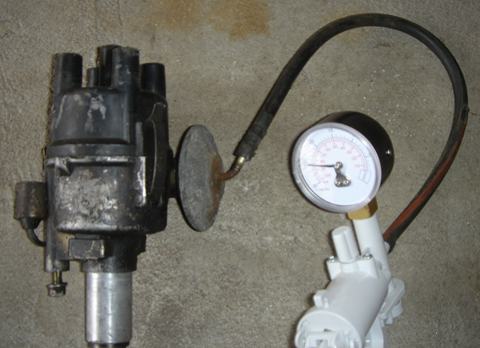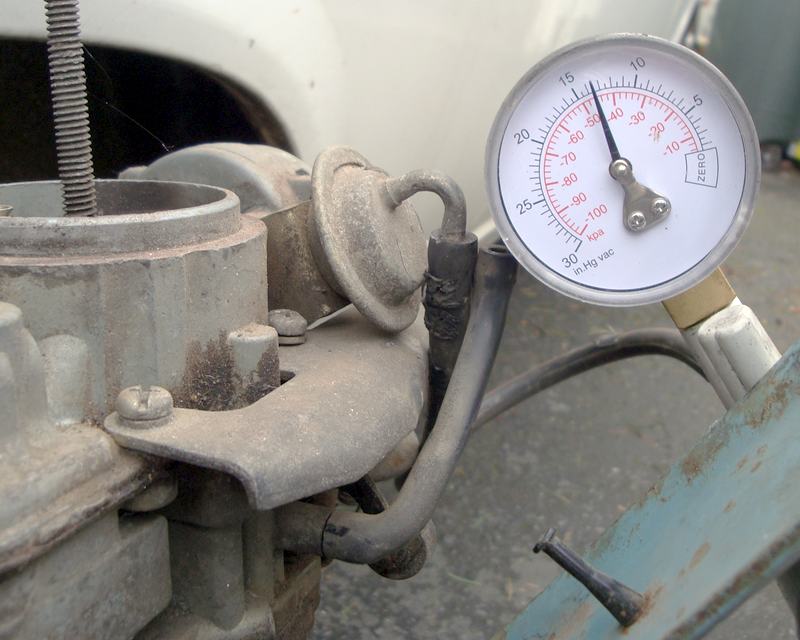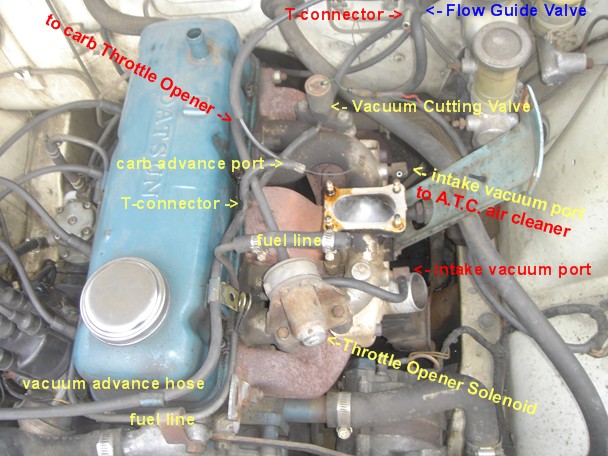Vacuum hoses on the 1200 follow a simple layout.
Contents |
Overview
Only two vacuum lines are needed to run great. All the other ports on the carburetor can be plugged.
1. VACUUM ADVANCE 2. CHOKE PULL-OFF
Vacuum Advance
The A12 will run good with the vacuum advance disconnected, but will run smoother and get better fuel economy with it working.
Connect a hose from the distributor to the port connection directly above the idle mixture screw.
Vacuum advance in all models uses a hose from the 'port' on the carburetor to the Distributor.
VACUUM ADVANCE. You want this as more advance = more power. This is a good system that adds extra performance, better fuel economy, and smoothness to the driving experience. And because vacuum is zero at full throttle, it has no effect on full throttle performance.
Just check to make sure it holds vacuum. Most are leaking. If yours is leaking, just plug the hose. It'll run better plugged than leaking. But you won't get good fuel economy, so best to replace it. Sometimes you can find them at wrecking yards still working. Or buy a new one for $75. Units from many other Datsuns fit, and some Honda and Subaru.
You can also test it without a vacuum gun. Move it with screwdrive and check to see if will hold under your thumb.
For more information, see Vacuum Advance
Carbon Canister
For late model 1200s, Tee into this line and connect a hose to the Charcoal Canister "VC" line. The canister is for the Fuel Tank vent. Since these fuel tanks are sealed, it needs to vent somewhere.
just three connections: 1. Fuel tank vent line (connection by itself) 2. PURGE - to intake manifold (bottom connector) 3. Vacuum Control (top connector) - to vacuum advance hose
Choke Pull-off
For Datsun 1200s with Automatic Choke
Choke Pull-off port, hose & diaphragm. Nissan calls this the "Vacuum Break"
This long black hose goes to the choke pull-off diaphragm (vacuum motor):
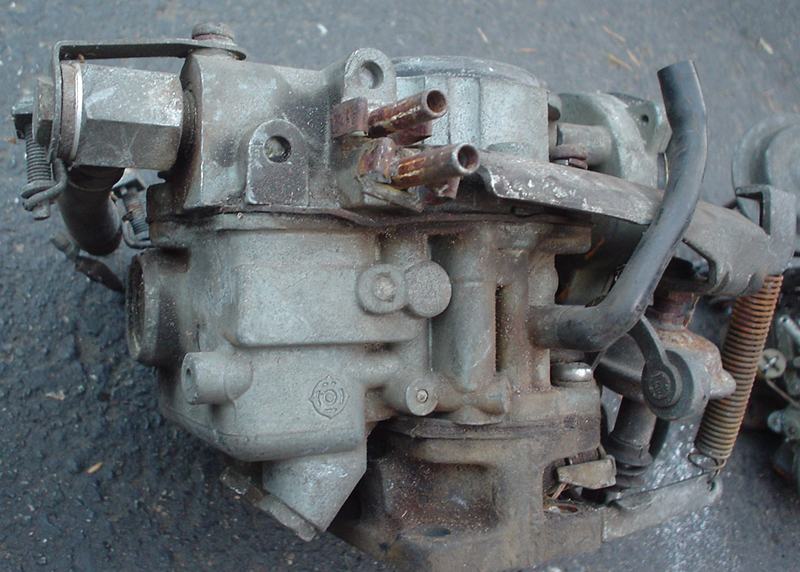
Test this diaphragm the same way as the vacuum advance.
Hopefully it won't be leaking. Again, better to plug this than have it leaking. You can drive the car with this plugged, but after a cold start it will run very rich for some time until the choke warms up a bit. It may even want to die unless you have your foot on the pedal a bit.
Only about $15 for a new one if you compare prices.
See Choke pull-off
EGR
EGR is used by Australia 1200 utes 1982-1985. 1989-up Japan 1200s & 1975-up USA B210 & B310 models
See EGR
3rd connector on carburetor is for EGR. If the EGR system is missing from your engine, then on carburetor plug the port connection that is slightly above the Vacuum advance port (and above the idle mixture screw on the rocker cover side of the carb).
For testing, you can drive the car under all conditions with the EGR port plugged. Performance should be equal or better with it plugged.
Throttle Opener
Throttle Opener diaphragm which is attached to the carburetor. Was used most USA B110 from 1972 and B210s except the FU engines (5-speed models).
For getting an engine first running, or for testing, remove the hose at the intake manifold and plug it. The engine will run good this way.
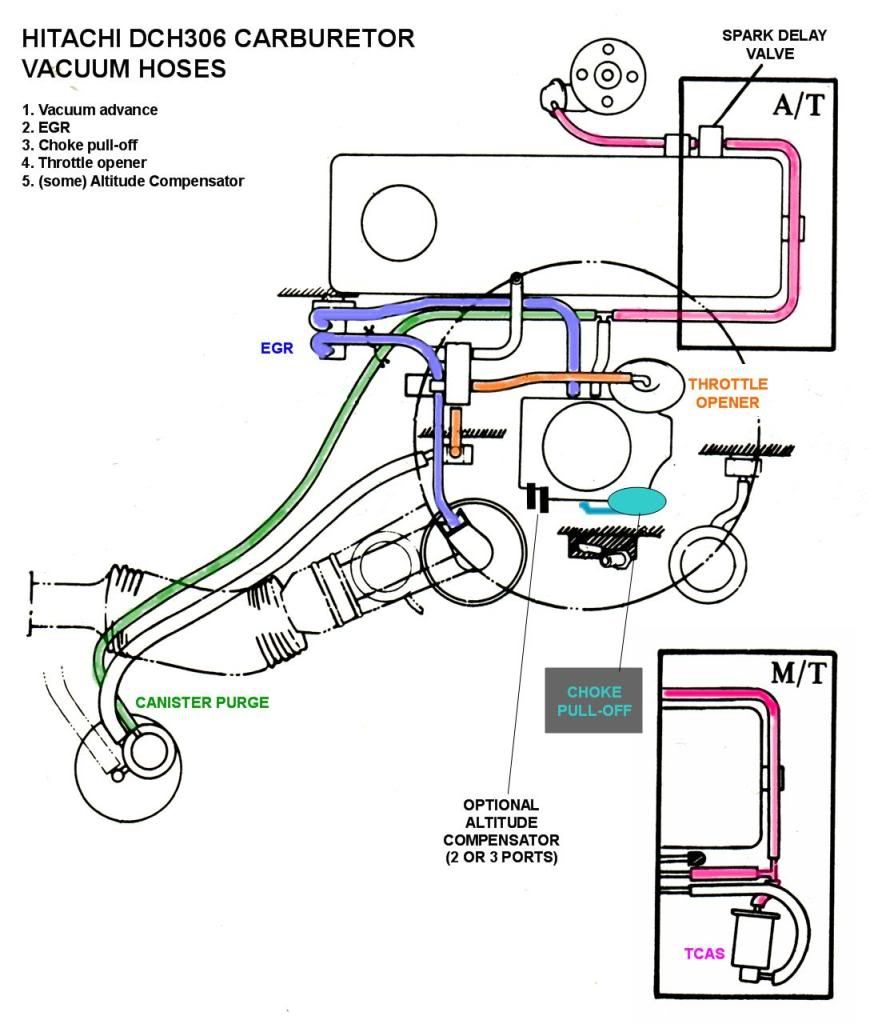
orange hoses in the diagram above: a single vacuum hose from the intake manifold to the switch. Then another from the switch to the Throttle Opener. In the diagram it shows a 3rd hose on the switch, which goes to the bottom of the air filter. That's all the hoses it uses. The rest is electrics.
If operating correctly, the throttle opener does not interfere with driving, although it does hold the throttle open a little during shifting. If misadjusted, it will be intrusive, holding the throttle open too far or for far too long.
Quick Test: Remove the hose at the intake manifold and plug it. See if the engine runs better. The car will drive OK with this plugged -- I think. Let us know how it works.
See Throttle Opener
Altitude Compensator
AC is for high altitude driving (over 4000 ft). Say if you go to Tahoe, it will run a bit rich w/o the altitude compensator. If you go to higher you can even notice it. The compensator takes care of that (assuming it still works after 35 years).
Altitude Compensator - 2 connectors near top of carburetor

For testing at low altitudes, remove the hoses and plug the ports coming out of the casting. The carburetor will run as normal. Most B210s didn't have this, but only those sold in california and in non-CAL high-altitude counties.
Warm Air
You won't get top fuel mileage if the warm-air intake doesn't work. Because the carburetors are jetted lean for a specific temperature. And you lose no performance. Because it runs off vacuum, when you floor it vacuum is zero, and the warm-air intake shuts thus drawing only cold air intake. The power valve compensates for the denser air at full throttle, so you get maximum power.
Early japan models had a manual winter/summer lever, so it would work to leave it at one position at least for anti-icing protection.
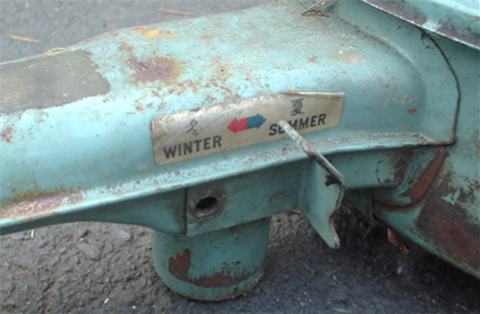
ATC
Nissan "Automatic Temperature-Control Air Cleaner" (A.T.C. Air Cleaner)
See ATC
Half the ones I work on are leaking. Check it a vacuum gun or use the finger method. You can reach up and push the flap open and see if it holds under your thumb. Plug if it is leaking.
Nissan "Automatic Temperature-Control Air Cleaner" (A.T.C. Air Cleaner)
The factory service manual doesn't have a good diagram showing the hose clearly except the visible one.
Vacuum Motor & exhaust manifold Duct Tube

1. Hose from intake manifold to the underside of the air cleaner
2. ATC [b]temperature sensor[/b], inside the air filter, is a large round or square thing. It has two hose connectors on the bottom side.
3. Hose from bottom of the air cleaner to the Heat Control Valve (vacuum motor diaphragm).
The hose can go to any port on the intake manifold.
Older models had it connected to the tap behind B in this photo...
 ... But you could connect it to D or C, as long as it is an intake manifold connection.
... But you could connect it to D or C, as long as it is an intake manifold connection.
At idle:
- Below 38F underhood temp, the hot air flap should be open (drawing hot air)
- Above 131F underhood, hot air flap should be closed (drawing 'cold' air)
- Between these temps, partially open. A slight hiss/buzz should be audible if the air cleaner lid is off.
If the vacuum motor is leaking, you could plug the hose. For winter you can jury-rig the air flap half way open like the Japan models.
USA
USA models have more emission controls, so a couple extra lines are used.
See: * Emission Controls#Throttle Opener * Emission Controls#Temperature Controlled Air Cleaner * Fume Control (for the Flow Guide Valve details) * TCVAS

![[Datsun 1200 encyclopedia]](/wiki/upload/wiki.png)


